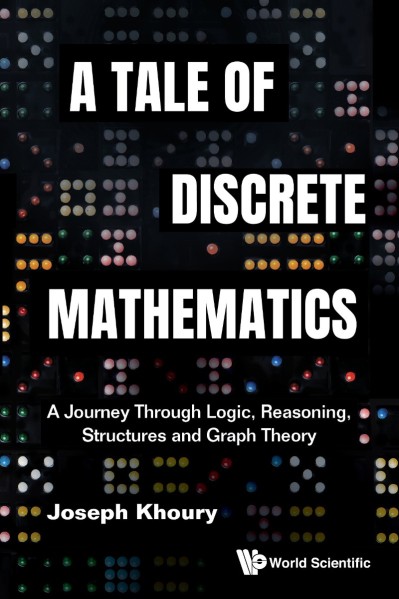
pdf | 15.95 MB | English| Isbn:9789811285806 | Author: Joseph Khoury | Year: 2024
Description:
Topics covered in Discrete Mathematics have become essential tools in many areas of studies in recent years. This is primarily due to the revolution in technology, communications, and cyber security. The book treats major themes in a typical introductory modern Discrete Mathematics course: Propositional and predicate logic, proof techniques, set theory (including Boolean algebra, functions and relations), introduction to number theory, combinatorics and graph theory.
An accessible, precise, and comprehensive approach is adopted in the treatment of each topic. The ability of abstract thinking and the art of writing valid arguments are emphasized through detailed proof of (almost) every result. Developing the ability to think abstractly and roguishly is key in any areas of science, information technology and engineering. Every result presented in the book is followed by examples and applications to consolidate its comprehension. The hope is that the reader ends up developing both the abstract reasoning as well as acquiring practical skills.
All efforts are made to write the book at a level accessible to first-year students and to present each topic in a way that facilitates self-directed learning. Each chapter starts with basic concepts of the subject at hand and progresses gradually to cover more ground on the subject. Chapters are divided into sections and subsections to facilitate readings. Each section ends with its own carefully chosen set of practice exercises to reenforce comprehension and to challenge and stimulate readers.
As an introduction to Discrete Mathematics, the book is written with the smallest set of prerequisites possible. Familiarity with basic mathematical concepts (usually acquired in high school) is sufficient for most chapters. However, some mathematical maturity comes in handy to grasp some harder concepts presented in the book.
Contents:[*]Propositional Logic: The Foundation of Mathematical Reasoning
[*]Set Theory and Introduction to Boolean Algebra: A Naïve Approach
[*]Prove It: Mathematical Proof Techniques
[*]Introduction to Predicate Logic: One Step Further
[*]Functions: Back to the Basics
[*]Elementary Number Theory
[*]Binary Relations
[*]Basic Combinatorics: The Art of Counting Without Counting
[*]Basics of Graph Theory
[*]More on Graph Theory
[*]TreesReadership: Undergraduate first-year and second-year students in mathematics, computer science, general science, physics and engineering. Anyone interested in learning the foundation of Mathematics.
Key [b]Features:[/b][*]Early introduction to the language of mathematics. Perhaps, one of the important features that sets this textbook apart from other textbooks the introduction of logic and mathematical reasoning at an early stage. A clear and thorough understanding of mathematical logic is key to fully grasp any mathematical concept. The author's experience in teaching some "transitional" courses like real analysis or abstract algebra shows that students' difficulties are not so much in grasping the theoretical concepts, but rather in properly expressing their reasoning and understanding of statements. A typical example is the confusion between the hypothesis and the conclusion in an implication
[*]Introduction to algorithms. The book contains several important algorithms in various topics. It is not very common for a typical Discrete Mathematics book to mix abstraction with practical algorithms. This combination enriches the book and widen the range of students who could benefit from it. Although the book does not include a chapter on writing and verifying algorithms, it lays down the mathematical foundation that fuels these algorithms. We explore, among others, Warshall algorithm to compute the transitive closure of a binary relation, the Euclidean algorithm to compute the GCD of two integers and express it as a linear combination, Havel-Hakimi algorithm to test graphical sequences, Ford-Fulkerson algorithm to find the maximum flow in a network
[*]A delicate balance between the theory and the applications. The textbook strikes a delicate balance between pure mathematical concepts and practical applications. This combination is what students should get from a Discrete Math course. This makes the textbook suitable for math majors, as well computer science and engineering students. Materials in the book can be used to design a one semester or a two-semester course on the subject
[*]Flexibility. Flexibility is desirable in any textbook, but difficult to achieve in general. This is even harder in a textbook on a cumulative subject like mathematics. This textbook exploits the diversity of topics covered to offer instructors and students a comfortable level of flexibility in choosing the order in which topics are covered. For example, one can choose to completely skip the chapter on Predicate Logic and still have good grasp on the remaining topics of the book. Another example is the chapter on Functions that can be approached from the point of view of the chapter on Relations. There are benefits from dedicating a separate chapter on functions, but the essence and main properties can be studied by treating functions as relations. Even within the same chapter, some sections can be treated independently of other sections and others can be optional and left to the discretion of the instructor
[*]Conciseness. Each topic covered in this textbook can be explored in a full textbook on its own. Efforts are made to ensure that the treatment of each subject captures the most important features in the most direct and concise way possible
[*]Fewer prerequisites. The only prerequisite for this course is a basic familiarity with mathematical fundamentals that can usually be acquired at the high school level. Each chapter is written in a relatively self-contained fashion
[*]Abundance of examples. Most definitions and major results are immediately followed with examples to facilitate the understanding and to grasp the concepts. The book contains hundreds of fully worked examples, carefully written to eliminate ambiguities and to cover as many scenarios as possible
[*]Extensive set of Exercises. Every section ends with its own set of suggested exercises designed to offer students a variety of practice problems. Some exercises have similarities to worked out examples in the section, others are designed to offer a bit more challenge to students. Exercises are also used in some occasions to explore some concepts not covered in the section in some unformal fashion
https://ddownload.com/beyf7ocyaesj
https://rapidgator.net/file/f2d670bd8c28729ebe60064d58c92d78/
https://turbobit.net/s6h4kzp5zvc7.html

